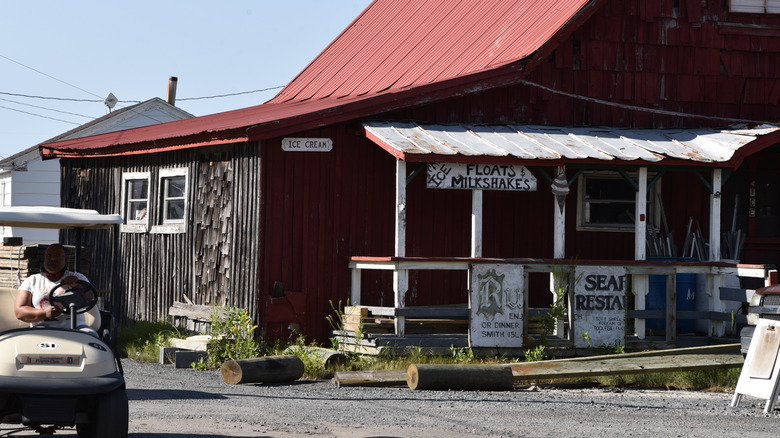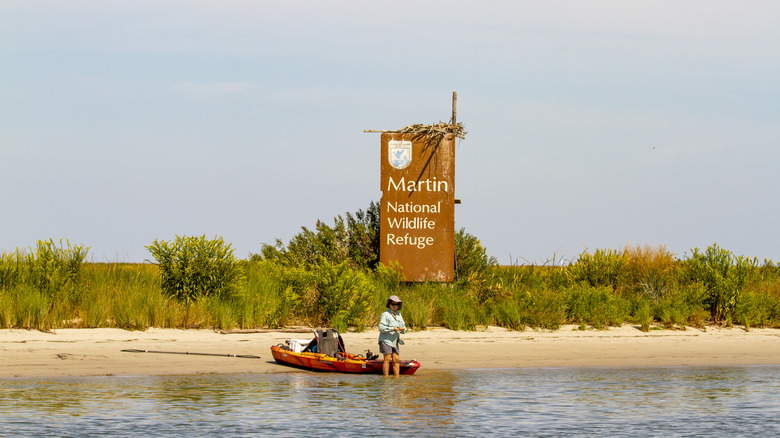This Remote Island Off Maryland's Coast Is A Relaxing Paradise With Divine Seafood
Just about every article you read about Smith Island in Maryland will tell you that it's a place stuck in the past – an age-old fishing community so isolated that its inhabitants retain an archaic dialect. While that may be the case, it is also an unusual historical East Coast destination that should be explored and enjoyed in the here and now. Smith Island is one of several waterlogged communities in the Chesapeake Bay that may be living on borrowed time. With rising sea levels, some scientists believe that it could suffer the same fate as Holland Island, which slipped beneath the waves of the bay in 2012.
With its future in the balance, Smith Island is a refuge for an endangered way of life that should be cherished while it lasts. Settlers from England arrived on the island in the 17th century, bringing with them an accent of which there are still traces today. Making a living from the surrounding waters, the populace peaked at around 1,000 people. Nowadays, it is home to around 450 residents, many of whom still earn a livelihood in the same way as their forebears through crabbing, fishing, and oyster dredging. It's a place that feels cut off: It is Maryland's only inhabited island accessible only by boat; Wi-Fi and cellphone coverage is patchy; and it's mostly a cash-only kind of economy (though there are no ATMs on the island). These combined factors make it a quirky and relaxing place to get away from it all and a must-visit for seafood lovers.
Getting to Smith Island, Maryland
The picturesque East Coast town of Smith Island sits in the Chesapeake Bay 12 miles west across the water from Crisfield, a small city on the Tangier Sound. Taking a boat is the only way to reach it, and ferries depart around twice a day. A single-day, round trip ticket costs around $30 for adults, and the crossing takes about 45 minutes. Some ferries might make additional stops at Tylerton (a small water community on a nearby island) or Ewell (to the north on Smith Island).
You can't take your car to Smith Island, but there are ways of getting around that aren't on foot. Bicycles and golf carts are available to rent from Bayside Inn in Ewell, and they're a good way of exploring. There isn't a whole lot to see on this quaint island, but it's worth stopping off at the Smith Island Cultural Center to learn about the local history. Any downtime will likely be filled by chatting with the locals, who are welcoming to visitors and usually only too happy to talk about their island home.
Getting out and about is one of the main attractions. Smith Island is mostly marshland and a fun way to explore is kayaking its waterways. The Smith Island Inn offers kayaks and canoes for free, and paddling the creeks is a great way to get acquainted with the island's wildlife, from its abundance of birds to the free-range inhabitants of nearby Goat Island.
Eating and drinking on Smith Island
The fruits of the sea are an important way of life on Smith Island, and sampling fresh seafood caught by local fisheries is an essential and tasty part of any visit. Bayside Inn is a family-style restaurant situated on the dock in Ewell, and its speciality is crab: Crab soup, steamed crab, soft shell crab, crab cakes. It's safe to say it's a great pick if you love crab! Also check out Harborside, a combo of grocery store and restaurant that is a favorite with the locals. The menu offers up the usual array of crab-based delicacies along with diner-style fare like burgers and cheesesteaks.
Drop into Drum Point Market if you make it across to Tylerton. It's a focal point for the tiny community selling groceries, souvenirs, and crab cakes that have achieved national recognition as some of the world's best. In 2016, USA Today readers voted Drum Point's chunky homemade cakes (made using the whole crustacean, not just the lump meat) as the sixth-best crab cake sandwich in Maryland.
When you're done gorging on crab and other seafood dishes, make sure you leave room for dessert. Smith Island is famous for its namesake cake, a seriously sweet treat with seven or more layers of chocolate fudge icing. Like just about everything else on the island, it has its roots in fishing. In the old days, wives would send their husbands off to work on the bay with a decent hunk in their bellies.


